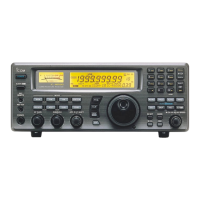(1)
WFM mode
The filtered 10.7 MHz 2nd
IF signal from the bandpass filter
(FI2) is
applied
to the WFM demodulator circuit
()C2,
pin
7).
The applied IF signal is mixed with
an LO
signal which
Is
generated
by
XI
to
demodulate AF signals. The
demodu-
lated
AF signals are
output from pin
13,
and
are then
applied to the
squelch
control
gate (ICl9d).
(2)
FM mode
The amplified 3rd IF signal
at the IF amplifier
(Q16)
is again
amplified at the other
IF
amplifier
(Q64)
and
then applied
to
the FM detector circuit (ICS,
pin
5).
The applied 3rd IF
signal
is mixed with the signal generated
by discriminator
(X2) to
demodulates AF signals.
The demodulated AF
signals are output from pin
9
and passed through
the
active
filter circuit
(IC32a) to suppress unwanted subaudible tone
audio signals and lower noise components.
The filtered
AF signals are
applied to the squelch control
gate (ICl9c).
(3)
AM
mode
The
amplified 3rd IF signal from
the IF amplifier
(Q16)
is
again amplified at the other IF amplifiers
(Ql7,
Q18).
The amplified 3rd IF signal
is then applied
to the AM
demodulator circuit
(015).
The
demodulated AF
signals
are
applied
to
the squelch control
gate (IC19b).
(4)
S5B and
CW
modes
The
amplified 3rd
IF
signal from the
IF amplifier
(Q18)
is
applied to the balanced mixer circuit
(IC7) and mixed with
BFO
signals
to
demodulate
AF
signals.
The demodulated
AF
signals are applied
to the squelch control gate (ICl9a).
The
BFO
signals
are
generated
at the
BFO
circuit
(PLL unit,
IC15) and
are applied
to the balanced mixer
circuit via the
buffer-amplifier
(Q31).
4-1-13
SQUELCH CONTROL CIRCUIT
(MAIN UNIT)
The
demodulated
AF
signals
from the demodulator
circuits
are applied
to
the squelch
control
gate
(IC19).
This con-
sists of 4 analog switches which are
selected with
a mode
signal 2und squelch control setting from
the CPU (IC33) via
the
expander
1C (IC18). The switched AF signals are
applied
to the AF circuit.
4-
1-14
SQUELCH CIRCUIT
(MAIN UNIT)
(1)
FM. FM-N, AM and
AM-W modes
A squelch
circuit cuts
out
AF signals when
no RF signal is
received
or the S-meter signal is lower
than the
[SQUELCH]
control
setting
level.
By
detecting
noise components in
the
AF signals, the
CPU
switches the
squelch control
gate.
Some noise
components
in the AF
signals
from pin
9 of the
FM IF
iC (ICS)
are applied
to
the
noise filter section in
the
FM IF IC
(pin
10).
The filtered noise components
are output
from pin
11,
and
then applied to the noise amplifier
circuit
(IC9b). The
amplified signals are rectified
at the noise
detector
circuit (D16) and the detected
voltages
are applied
to the
CPU (IC33)
via the
NOAD line after being
current-
amplified at
the
current-amplifier
circuit
(IC4a).
The
[SQUELCH] control
level
signal is applied
to the
CPU
(IC33)
via
the sub-CPU (FRONT
unit, IC1) as a reference
voltage
for comparison with the
noise
voltages.
Also, an
5-
meter signal is applied to the
CPU
from the
meter ampli-
fier (IC9a). The
CPU
compares
these signals,
then outputs
a
control
signal
to the
squelch
control gate.
The FM
IF IC
detects noise
components even in AM and
AM-W modes for noise squelch
control, and also
the IF
amplifier
(Q18)
is
activated
in FM
and FM-N modes
for
S-meter and S-meter squelch
functions.
(2)
WFM, S5B,
CW
and AM-N
modes
The squelch circuit mutes AF
output when the
S-meJter
signal is lower
than the [SQUELCH] control
setting level.
*
SSB,
CW and
AM-N
modes
A portion of the 3rd IF signal from
the IF amplifier
(Q18)
Is
converted
into DC voltage at the
AGC
detector
(Q27.
D20)
and the meter amplifier (lC9a).
The amplified signal
is
applied to the CPU
(IC33)
via
the SMAD line. The
CPU
outputs control signals
to the squelch control
gate when the
S-meter signal is at a low level.
WFM
mode
The WFM demodulator
(IC2) controls
input
voltage
of
the
meter amplifier
(IC9a, pin
2)
via
Q6
and
the AGC line.
The
same circuit is
used even in WFM
mode with
SSB,
CW and
AM-N
modes.
•
Squelch and AF amplifier
circuits
4-4

